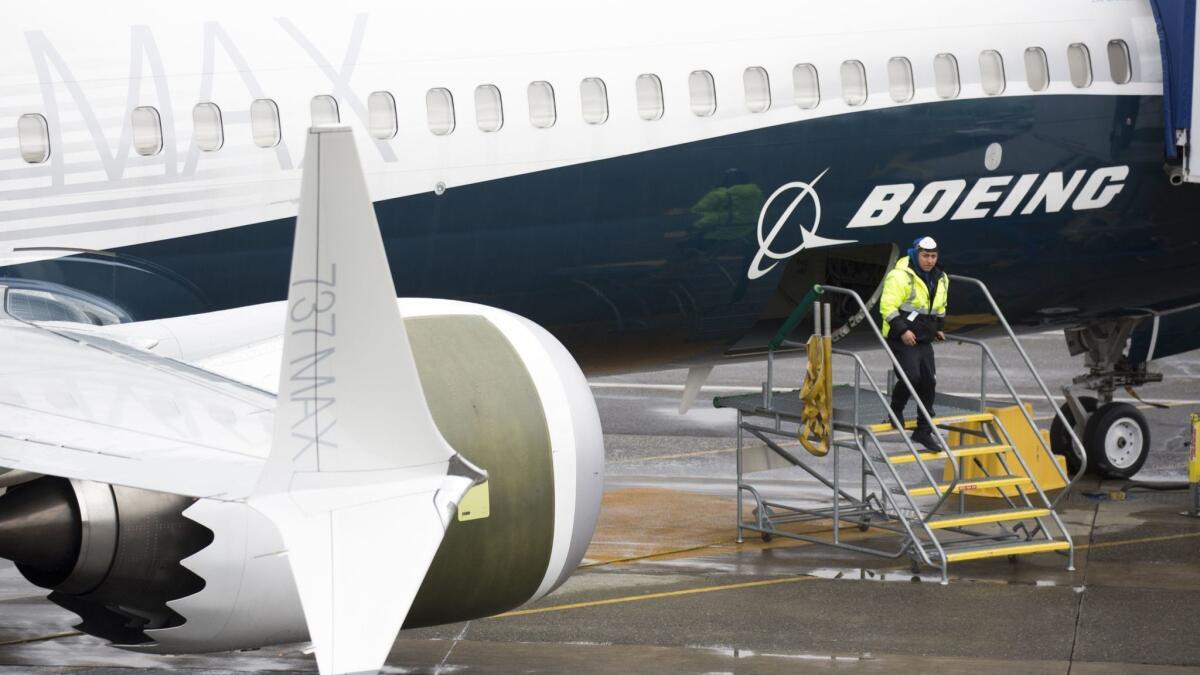Investigators zero in on Boeing 737 Max crash data and probe jet’s approval process

- Share via
Air crash experts gathered in Ethiopia to analyze voice and data recorders from a Boeing 737 Max jetliner as controversy over the model’s safety intensified following two fatal disasters in less than five months.
Experts from Ethiopia, the U.S., France and the European Union will study cockpit voice and flight data recorders, the Ethiopian Transport Ministry said Thursday in an emailed statement.
The U.S. Transportation Department has meanwhile ordered a full audit of the Max’s 2017 certification. The Justice Department is also using a grand jury to help gather information. Weeks after a brand-new Lion Air 737 Max crashed in October in the waters off Indonesia, investigators representing the two departments and the FBI began digging into the Federal Aviation Administration’s approval of a software system linked to the accident and why Boeing Co. didn’t flag the feature in pilot manuals.
Boeing has said it will soon release a software update and further pilot training guidelines for the Max that will address concerns. The New York Times said the manufacturer will stop charging for a safety feature the two foreign 737s lacked. That feature, called the disagree light, is activated if a plane’s sensors are at odds.
The inquiry into the Maneuvering Characteristics Augmentation System, or MCAS, software, has taken on new urgency since an Ethiopian Airlines 737 Max 8 fell from the sky in a similar fashion to the Lion Air plane minutes after taking off from Addis Ababa, Ethiopia, earlier this month. In the aftermath, regulators around the world grounded the popular Boeing model.
For months, U.S. investigators have been digging into a range of matters related to MCAS, said people familiar with the probe who asked not to be identified since it is confidential. Representatives of Boeing and the federal agencies declined to comment.
“If I were a prosecutor, I would be looking at mail and wire fraud,” said Gene Rossi, who spent three decades trying civil and criminal cases for the U.S. Justice Department. He said investigators are likely to examine whether documents related to the 737 Max exchanged between the FAA and the company contained any falsehoods, and whether Boeing executives made any false statements to regulators.
“It could be a treasure trove — if it’s there — but if I were a prosecutor I would definitely look at it,” said Rossi, who now is with the Washington law firm Carlton Fields and is not involved in the Boeing investigation.
One facet of the probe is exploring why pilots were widely unaware of the system, said a person familiar with it. There’s no explanation of MCAS, or the steps needed to counter it, in U.S. and European pilot manuals. Boeing reasoned that pilots were already drilled to counter similar behavior by the 737’s horizontal stabilizer by running through a checklist and flipping two center console switches. The FAA reviewed Boeing’s analysis and agreed.
The MCAS does make an appearance in American Airlines Group Inc.’s flight crew operations manual — in a section that lists acronyms.
The system had baffled the Lion Air pilots by pushing their plane’s nose downward dozens of times, exerting more and more force until they lost control. The software patch was supposed to counteract the changed center of gravity on the Max, which boasts larger and more powerful engines than its 737 predecessors.
The MCAS intervenes automatically, without a pilot’s knowledge, when a single sensor indicates the aircraft may be approaching a stall. The so-called angle-of-attack vane on the Lion Air plane provided a faulty reading.
In the case of the doomed Lion Air jet, the same aircraft was saved from disaster the previous day when an off-duty pilot told the crew how to disable the stall-prevention MCAS software. Indonesia confirmed that a third airman was in the cockpit.
With pressure mounting on Boeing over the troubled jet’s certification process, establishing the cause of the Ethiopian tragedy has become critical.
While Ethiopia is leading the investigation, a spokesman for France’s Bureau of Inquiry and Analysis for Civil Aviation Safety said Wednesday that three of its experts would travel to Ethiopia to participate after the agency downloaded the flight data and cockpit audio recordings in Paris. The U.S. National Transportation Safety Board, the FAA and Boeing were also invited, he said.
Indonesia’s National Transportation Safety Committee has also offered to aid Ethiopian authorities, Chairman Soerjanto Tjahjono said at a news briefing in Jakarta on developments in its investigation into the Lion Air crash.
Ethiopian Airlines had said the initial decision to send the so-called black boxes to France for decoding was strategic after the FAA was left isolated in the days after the crash, arguing that the Max should continue flying after other authorities had already grounded it. The French civil aviation safety agency has handled other major disasters in the past, including Air France Flight 447, which was lost in the Atlantic Ocean in 2009, and Germanwings Flight 9525, flown into a mountainside in 2015 by its co-pilot.
More to Read
Inside the business of entertainment
The Wide Shot brings you news, analysis and insights on everything from streaming wars to production — and what it all means for the future.
You may occasionally receive promotional content from the Los Angeles Times.










